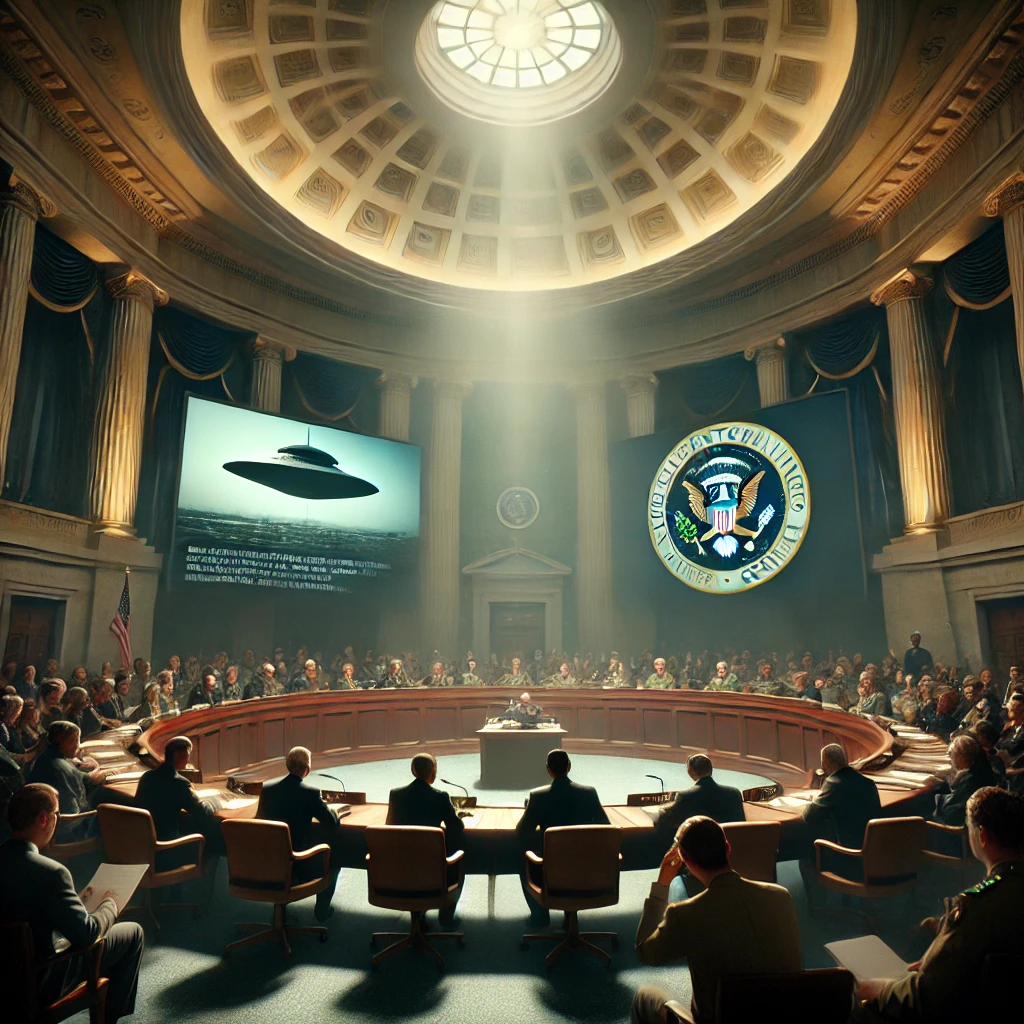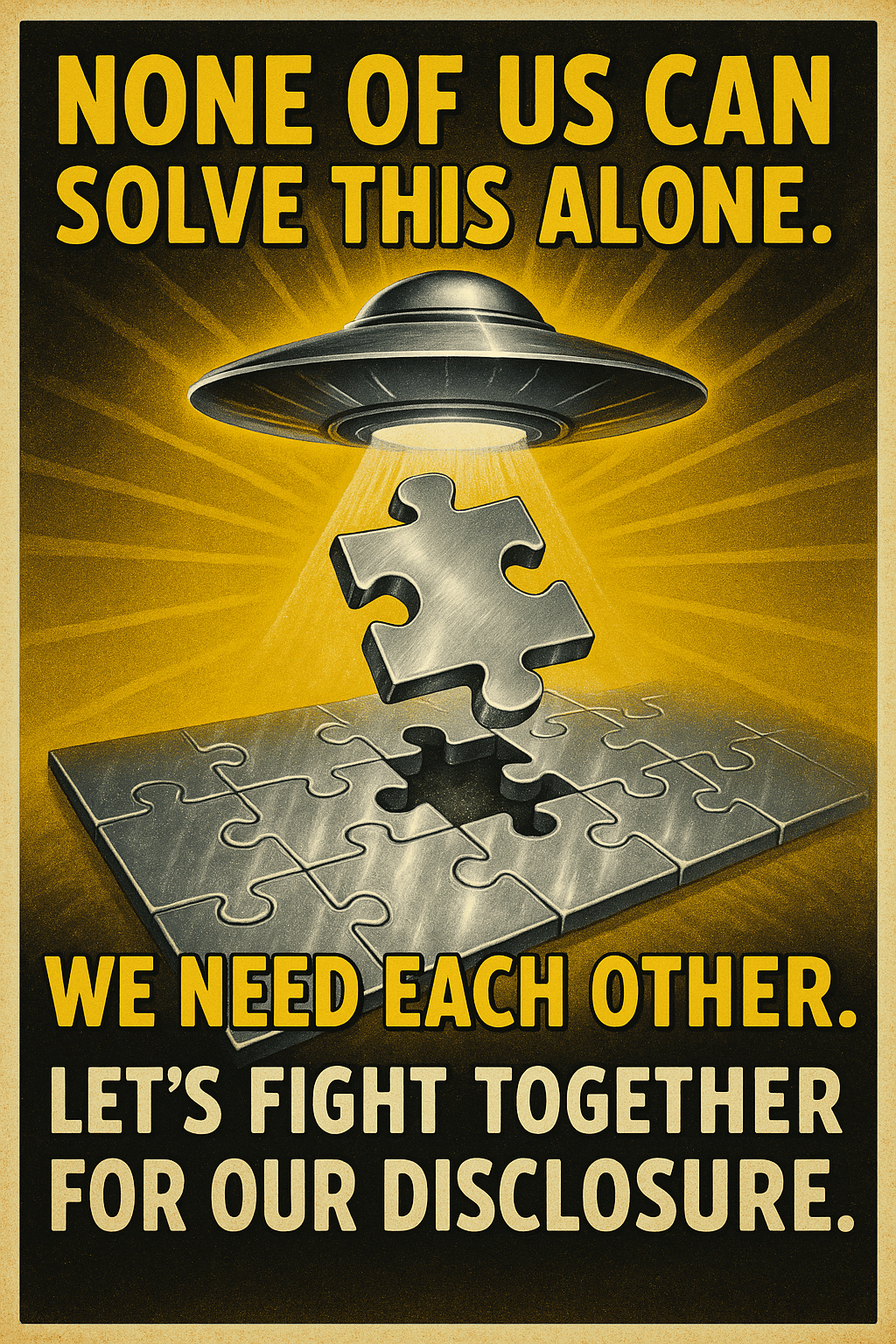Congressional Hearing Reveals U.S. Government Secrecy on UAPs: Testimonies, Whistleblowers, and Classified Programs

The November 13, 2024, congressional hearing titled Unidentified Anomalous Phenomena: Exposing the Truth provided critical insights into the U.S. government’s knowledge and handling of Unidentified Anomalous Phenomena (UAPs). Witness testimony strongly indicated that UAPs are a legitimate national security concern, with multiple incidents involving military personnel, intelligence officials, and pilots encountering objects exhibiting extraordinary flight characteristics and unknown origins.
However, in the days following the hearing, concerns arose over selective information control, redacted records, and the exclusion of key witnesses. While officials presented a narrative of careful investigation and national security priorities, emerging controversies surrounding missing documentation, blocked testimonies, and government secrecy suggested a deeper struggle over what the public is allowed to know. The implications of these revelations would only grow as whistleblowers and journalists pushed back against what they saw as a controlled and incomplete disclosure.
Retired Rear Admiral Tim Gallaudet detailed his firsthand experience with a UAP-related safety incident during a naval exercise in 2015. He revealed that key communications on the matter were mysteriously deleted, leading him to conclude that classified programs within intelligence agencies may be handling UAP data outside of standard oversight. Gallaudet expressed concern over the lack of government response to these incidents, emphasizing that pilots were left to navigate these encounters without official guidance or support.
Luis Elizondo, a former Department of Defense official, testified that highly advanced technologies, not manufactured by any known government, are actively monitoring sensitive U.S. military installations. He further asserted that the U.S. government has engaged in secret UAP crash retrieval and reverse-engineering programs. However, he was restricted by a non-disclosure agreement from providing further specifics in a public setting. His statements aligned with other whistleblowers who have alleged a long-standing secrecy campaign within the government to suppress UAP-related disclosures. Elizondo also described a pattern of retaliation against individuals who attempt to expose information regarding these programs.
Journalist Michael Shellenberger introduced a leaked document detailing a classified U.S. military program called Immaculate Constellation, allegedly responsible for tracking and analyzing UAPs using high-resolution imagery and intelligence sources. The document suggests the existence of a centralized repository of UAP sightings and data, directly contradicting official narratives that the government lacks substantial evidence on the subject. Shellenberger emphasized that the U.S. military and intelligence community possess hundreds, if not thousands, of high-definition images and videos of UAPs, yet these remain classified. He further detailed accounts of UAPs interfering with military aircraft, including an instance in which orbs surrounded and forced an F-22 out of its patrol area.
NASA’s former Associate Administrator Michael Gold focused on the scientific and technological implications of UAP research. He argued that NASA’s reputation and resources could be instrumental in normalizing UAP studies, advocating for a centralized civilian database to collect reports from pilots and the public. Gold underscored that scientific advancements often emerge from studying anomalies and criticized the stigma surrounding UAP research, which has hindered legitimate scientific inquiry. He also proposed that NASA leverage its Aviation Safety Reporting System (ASRS) to gather and analyze UAP-related data, creating a publicly accessible repository for independent research.
The hearing also addressed broader concerns about government transparency, excessive classification, and the erosion of public trust. Several committee members voiced frustration over the Pentagon and intelligence agencies withholding critical UAP-related information from both Congress and the public. The committee highlighted the inadequacies of the All-domain Anomaly Resolution Office (AARO), questioning whether it was truly committed to uncovering the truth about UAPs or merely serving as a bureaucratic shield for continued secrecy. Lawmakers called for increased oversight, the declassification of relevant materials, and the establishment of a secure channel for whistleblowers to provide testimony without fear of retaliation.
The attached PDF contains the full official transcript of the November 13, 2024, congressional hearing on UAPs, detailing witness testimonies, government statements, and key discussions on national security and transparency. It provides further context and evidence for the claims presented during the hearing, making it an essential resource for those seeking a deeper understanding of the subject.
The December 9, 2024, House Oversight Committee’s Post-Hearing Questions for Dr. Tim Gallaudet shed further light on the pressing issue of Unidentified Anomalous Phenomena (UAPs). This follow-up to the November 13, 2024, congressional hearing, Unidentified Anomalous Phenomena: Exposing the Truth, featured a series of detailed inquiries from Representative Eric Burlison, seeking clarification on key points regarding government and defense contractor knowledge of non-human technologies and materials.
Dr. Tim Gallaudet, a retired Rear Admiral and former NOAA Administrator, was asked whether any branch of the U.S. government or defense contractors possessed technology derived from non-human sources. While he stated that he had seen no direct evidence, he acknowledged being in contact with credible former U.S. government officials who have asserted such evidence exists. Some of these individuals have provided public testimony, while others remain anonymous.
Another key question addressed whether any branch of the U.S. military or defense contractors employed exotic materials of non-human or non-terrestrial origin. Gallaudet again stated that he had seen no evidence supporting such claims. Similarly, when asked if the U.S. government or its contractors had made undisclosed breakthroughs in physics, he reported no direct knowledge of such advancements.
The discussion extended to the potential recovery of craft of non-human origin. Gallaudet maintained that he had not personally encountered such evidence but reiterated that credible sources within government circles have claimed otherwise. While he did not confirm whether non-human entities were associated with such recovered craft, the question itself underscores the seriousness of congressional inquiry into the matter.
The hearing also examined the nature of UAPs, questioning whether they might be extra-dimensional rather than extraterrestrial. Gallaudet refrained from speculation, citing his limited expertise in physics, but acknowledged the possibility that the phenomena could challenge traditional scientific understanding.
Additionally, Gallaudet provided insight into reported incidents involving Unidentified Submerged Objects (USOs). He recounted a specific case in which a former U.S. Navy ballistic missile submarine officer detected a USO on sonar, prompting evasive maneuvers. This report, though anecdotal, suggests that UAP phenomena extend beyond aerial encounters and may pose unknown implications for naval operations.
This post-hearing exchange highlights the growing momentum for transparency and further investigation into UAPs. While Gallaudet did not confirm direct government possession of non-human technology, his acknowledgment of credible testimony from government insiders reinforces the need for continued congressional oversight and disclosure.
The attached PDF contains the full record of the House Oversight Committee’s post-hearing questions for Dr. Gallaudet, including his responses and additional details on UAP-related inquiries. It serves as an essential resource for those seeking a comprehensive understanding of the ongoing congressional investigation into UAPs.
The December 9, 2024, House Oversight Committee’s Post-Hearing Questions for Luis Elizondo provided additional insights into government knowledge and potential concealment of Unidentified Anomalous Phenomena (UAPs). This document, following the November 13, 2024, congressional hearing titled Unidentified Anomalous Phenomena: Exposing the Truth, contains questions posed by Representative Eric Burlison regarding non-human technology, classified materials, and alleged obstruction by intelligence agencies.
Luis Elizondo, former head of the Advanced Aerospace Threat Identification Program (AATIP), was directly asked whether any branch of the U.S. government or its contractors possessed technology derived from non-human sources. Elizondo confirmed that, during his tenure, senior defense aerospace executives claimed to possess exotic materials not originating from any known human source. These materials were initially set to be transferred to AATIP for analysis but were ultimately retained due to interference by unknown parties.
A significant portion of the inquiry focused on defense contractor Lockheed Martin and its alleged possession of non-human technology. Elizondo confirmed that discussions took place regarding the transfer of such materials to Bigelow Aerospace. However, he indicated that both the CIA and factions within the U.S. Air Force actively blocked this transfer, raising concerns about institutional secrecy and obstruction of congressional oversight efforts.
When questioned about potential breakthroughs in physics that remain undisclosed to the public, Elizondo affirmed that classified advancements exist. He stopped short of providing specifics but suggested that scientific progress tied to UAP studies has been withheld from both academia and the broader public.
The discussion also touched on the possibility of UAPs being extra-dimensional rather than extraterrestrial. Elizondo noted that several scientists within AATIP considered this hypothesis seriously, suggesting that UAPs could interact with human consciousness or exist beyond traditional space-time constraints. He also referenced the unusual correlation between UAP activity and large bodies of water, indicating that some phenomena might originate from Earth’s oceans rather than deep space.
Perhaps the most startling revelation came in response to whether non-human entities had been recovered alongside UAP craft. Elizondo confirmed that he was aware of multiple incidents where biological specimens of non-human origin were recovered. However, he could not verify whether any of these entities were found alive at the time of recovery.
Elizondo further disclosed that individuals advocating for UAP transparency within government agencies have faced retaliation, including threats to their security clearances and personal safety. He characterized this as a deliberate effort to suppress the release of classified UAP-related materials to the public.
The attached PDF contains the full record of the House Oversight Committee’s post-hearing questions for Luis Elizondo, including his responses regarding UAP recoveries, secret defense projects, and government interference in disclosure efforts. This document is a crucial resource for understanding the depth of congressional inquiry into the U.S. government’s handling of UAP evidence.
The December 9, 2024, House Oversight Committee’s Post-Hearing Questions for Michael Shellenberger further examined allegations of secret government programs related to Unidentified Anomalous Phenomena (UAPs). This inquiry, stemming from the November 13, 2024, congressional hearing titled Unidentified Anomalous Phenomena: Exposing the Truth, focused heavily on Shellenberger’s investigation into the classified program known as Immaculate Constellation and its implications for government transparency.
Shellenberger was asked to elaborate on the scope and methodology of his investigation into Immaculate Constellation, including details on his sources and the credibility of whistleblowers he consulted. He confirmed that he thoroughly vetted his sources but declined to reveal their identities beyond what he had already disclosed in his testimony.
When questioned about the purpose and structure of Immaculate Constellation, Shellenberger declined to provide additional information beyond his initial testimony. However, his previous statements indicated that the program is allegedly responsible for collecting and analyzing UAP-related data across multiple intelligence agencies. He also referenced an extensive database purportedly containing UAP-related imagery, videos, eyewitness accounts, and electronic sensor evidence, though he did not provide further specifics beyond what was shared in the hearing.
One of the most contentious points raised was the Department of Defense’s (DoD) official denial of Immaculate Constellation’s existence. In response, Shellenberger pointed to the DoD’s history of misinformation on UAPs, citing previous instances where the Pentagon denied drone activity in restricted airspace before later admitting such incidents had occurred. He suggested that similar tactics were being used to obscure the reality of Immaculate Constellation and its findings.
The implications of Immaculate Constellation, according to Shellenberger, are profound. He asserted that the program confirms the U.S. government’s long-term study of UAPs dating back to the 1940s and that it has actively spread disinformation regarding its research. His remarks underscored the idea that government agencies have been withholding UAP-related discoveries without justifiable national security reasons.
In his recommendations to Congress, Shellenberger praised lawmakers for their increasingly assertive stance on UAP disclosure and urged them to demand full transparency. He argued that the Department of Defense and other intelligence agencies must be compelled to release all relevant UAP data to the public. He further emphasized that ongoing secrecy lacks valid national security justifications and only serves to erode public trust.
The attached PDF contains the full record of the House Oversight Committee’s post-hearing questions for Michael Shellenberger, including his responses regarding Immaculate Constellation, alleged government disinformation efforts, and recommendations for legislative action. This document is an essential resource for those seeking a clearer understanding of the government’s role in UAP research and secrecy.
The December 9, 2024, House Oversight Committee’s Post-Hearing Questions for Michael Gold provided further insights into the role of NASA and private aerospace firms in Unidentified Anomalous Phenomena (UAP) research. This inquiry, following the November 13, 2024, congressional hearing titled Unidentified Anomalous Phenomena: Exposing the Truth, focused on Gold’s tenure at Bigelow Aerospace and NASA, as well as the potential for public-private collaboration in UAP investigation.
Michael Gold, a former NASA Associate Administrator and a member of NASA’s UAP Independent Study Team, was questioned about government and contractor possession of non-human technology. While he stated he had no firsthand knowledge of such materials, he emphasized his trust in fellow witness Luis Elizondo, suggesting that his claims about recovered UAP materials should be taken seriously.
Gold was also asked whether government agencies or defense contractors had made undisclosed breakthroughs in physics related to UAPs. He denied any direct knowledge but speculated that technology enabling interstellar travel might appear extra-dimensional in nature. He entertained theories suggesting that UAPs could be highly advanced human travelers from the distant future, though he maintained that extraterrestrial intelligence remained the more plausible explanation for certain phenomena.
A significant portion of the inquiry centered on Gold’s role at Bigelow Aerospace from 2003 to 2016, where he served as Director of D.C. Operations & Business Growth. He clarified that his duties focused primarily on congressional relations, space agreements, and commercial partnerships, and that UAP-related research was conducted by a separate entity, Bigelow Aerospace Advanced Space Studies (BAAS). He denied having direct involvement in or knowledge of efforts to transfer non-human materials from Lockheed Martin to Bigelow Aerospace, though he acknowledged that the House Committee could benefit from a more in-depth briefing on AAWSAP, the government’s Advanced Aerospace Weapon System Applications Program.
Gold also addressed opportunities for collaboration between private industry and government agencies in UAP research. He suggested that NASA leverage artificial intelligence and machine learning to scan its vast archives for UAP-related data and expand its Aviation Safety Reporting System (ASRS) to include UAP encounters from commercial airline pilots. Additionally, he recommended that NASA include UAP data collection clauses in agreements with private sector partners to encourage broader transparency.
He concluded by urging NASA leadership to establish a permanent UAP research office, stressing the importance of public trust and transparency. Gold noted that recent UAP sightings over New Jersey and other states further underscored the urgency of sustained scientific investigation.
The attached PDF contains the full record of the House Oversight Committee’s post-hearing questions for Michael Gold, including his responses regarding UAP-related materials, NASA’s role in disclosure, and the potential for private sector collaboration. This document is an essential resource for understanding the ongoing intersection of government, science, and industry in UAP research.
The November 13, 2024, congressional hearing titled “Unidentified Anomalous Phenomena: Exposing the Truth” has intensified debates over governmental transparency concerning UAPs. Testimonies from figures such as Luis Elizondo, Michael Shellenberger, Michael Gold, and Tim Gallaudet have underscored a persistent reluctance within government agencies to disclose critical UAP findings to the public.
Investigative journalist Jeremy Corbell has been particularly vocal, criticizing the hearing as “dishonest” and “controlled.” He alleges that behind-the-scenes manipulations and underhanded tactics have shaped the narrative, leading to the exclusion of vital testimonies and evidence. Corbell’s concerns are echoed by journalist George Knapp, who points to deliberate efforts to restrict inquiry scope and control information flow. These allegations suggest a broader agenda to maintain secrecy around UAP phenomena, fueling skepticism about the integrity of the process.
Further complicating matters, recent drone activities over New Jersey have sparked public concern. White House Press Secretary Karoline Leavitt stated that these drones were authorized by the Federal Aviation Administration (FAA) for research and various other reasons, including hobbyist and recreational use. However, this explanation has been met with skepticism, as some reports suggest the FAA may not have full knowledge of all such activities, leading to questions about oversight and the potential for unauthorized aerial operations.
Collectively, these developments reveal an ongoing struggle between advocates for disclosure and governmental elements resistant to full transparency. As more evidence emerges and public scrutiny intensifies, the demand for accountability in UAP research is unlikely to diminish. The attached documents and testimonies provide crucial context for understanding the broader implications of these events and underscore the necessity for continued congressional oversight into UAP-related matters.


